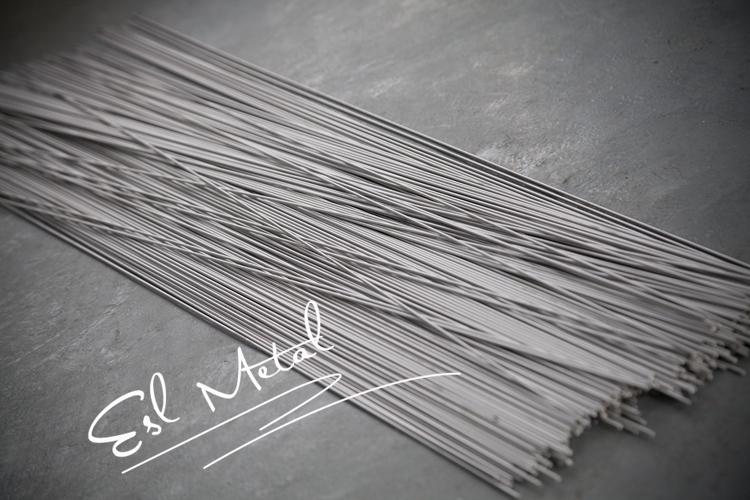
Grade 1 Titanium Wire/Titanium implants dental/titanium grade 1 wire/pure titanium eyeglass frames//rust resistant wire/titanium mig welding wire
Eastsun Titanium is one of the most reliable manufacturers and suppliers of grade 1 titanium wire. Our company has a professional factory from which you can wholesale grade 1 titanium wire products.
Titanium grade 1 (ERTi-1) is commonly referred to as commercially pure (CP.) titanium with the level of impurities
and mechanical properties increasing slightly from ERTi-1 to ERTi-4. ERTi-1 is the lowest strength unalloyed, or commercially pure titanium available. It is normally used in applications where ductility is paramount. Applications include explosive cladding, expanded metal, and deep drawing applications. As with all titanium alloys, ERTi-1 is extremely reactive above 1000°F and extra precaution must be taken to have a successful weld. ERTi-a can be welded by the GTAW, GMAW and plasma arc processes.
· STANDARD of Grade 1 Titanium Wire
AWS A5.16; ASTM B863; AMS 4951; AMS 4954; AMS 4956,etc.
· SPECIFICATION of Grade 1 Titanium Wire
Starting from dia0.80mm to dia4.0mm.
· SURFACE
Pickled , Bright
· CHEMICAL COMPOSITIONS
C 0.03 O 0.03 - 0.10 N 0.012 H 0.005 Fe 0.08 Ti rem.
· APPLICATIONS
Titanium wire is typically used in welding,Titanium grade 1 Welding rods is used for gas-tungsten-arc-welding
(GTAW), gas-metal-arc-welding (GMAW) and plasma-arc-welding (PAW).And also used in Spring,medical.seawater
and brackish water heat exchanger, chemical process heat exchangers, pressure vessels and piping systems, pulp
bleaching systems, air pollution control scrubbers, and electro chemical and chemical storage tanks. These grades
also have some uses in the aerospace industry.
· TYPICAL MECHANICAL PROPERTIES
Tensile strength: 240 MPa (34,800 psi)
Yield strength: 170 MPa (24,650 psi)
Elongation: 20%
· QUALITY & TEST
Strict test to ensure our quality,The third Party Inspection acceptable,EN 10204 3.1 is available
(Quality Certification ISO9001-2008)
· PACKAGING
Straight Lengths: 18", 24", 36" and custom
Spool: 12" diameter standard spool
Coil: by meter or kgs
Flag Tagging Available
· CLASSIFICAZIONE
AWS A5.16 ERTI-1 AMS4951 UNS R50100
· FEATURE
Titanium and Titanium Alloys offer the best in strength to weight ratios, and in corrosion resistance to acids, chlorides and salt. Titanium is approximately 45% lighter than steel and 60% heavier than aluminum. You will find Titanium commonly used for military applications, aerospace, marine, chemical plants, process placts, power generation, oil and gas extraction, medical and sports applications.
·WELDING TECHNIQUE
In addition to clean joints and weld wire, proper parameters, and proper inert gas shielding, welder technique requires attention when titanium is being welded. Improper technique can be a source of weld contamination. Before starting an arc in welding titanium, it is good practice to pre-purge torch, trailing shield and backup shield to be sure all air is removed. Whenever possible, high frequency arc starting should be used. Scratch starting with tungsten electrodes is a source of tungsten inclusions in titanium welds. On extinguishing the arc, the use of current downslope and a contactor, controlled by a single foot pedal, is encouraged. Torch shielding should be continued until the weld metal cools below 800 degrees F. Secondary and backup shielding should also be continued. A straw or blue color on the weld is indicative of premature removal of shielding gas. Preheating is not generally needed for titanium shop welds. However, if the presence of moisture is suspected, due to low temperature, high humidity, or wet work area, preheating may be necessary. Gas torch heating (slightly oxidizing flame) of weld surfaces to about 150 degrees F. is generally sufficient to remove moisture. The arc length for welding titanium without filler metal should be about equal to the electrode diameter. If filler metal is added, maximum arc length should be about 1-1/2 times the electrode diameter. Filler wire should be fed into the weld zone at the junction of the weld joint and arc cone. Wire should be fed smoothly and continuously into the puddle. An intermittent dipping technique causes turbulence and may result in contamination of the hot end of the wire on removal from the shield. The contaminants are then transferred to the weld puddle on the next dip. Whenever the weld wire is removed from the inert gas shielding, the end should be clipped back about 1/2- inch to remove contaminated metal. Interpass temperatures should be kept low enough, such that additional shielding is not required. Cleaning between passes is not necessary if the weld bead remains bright and silvery. Straw or light blue weld discoloration can be removed by wire brushing with a clean stainless steel wire brush. Contaminated weld beads, as evidenced by a dark blue, gray or white powdery color, must be completely removed by grinding. The joint must then be carefully prepared and cleaned before welding again.
More Specification pls kindly check EST Metal-Titanium Wire Catalogue
EST Metal Titanium Welding Rods Catalogue
EST Metal-Titanium Wire with DIN300 Spool
EST Metal-Titanium Wire with DIN140 Spool

EST Metal Titanium wire available in spools,in cut straight lengths or in a variety of size/diameters.For more questions, please forward your requirements to sales@tirods.com.
prev:Grade 2 MIG Titanium Wire
next:Grade 5 ELI Titanium Wire